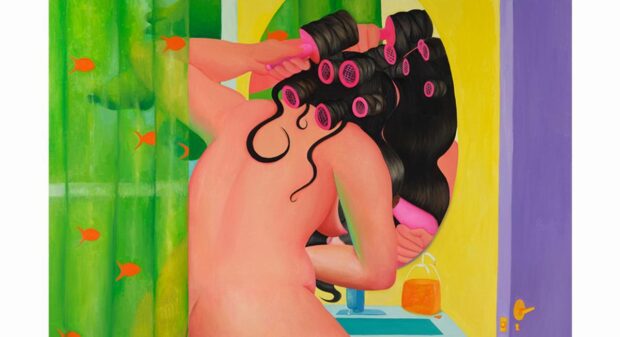At the Metropolitan’s hosting of the SFMOMA retrospective exhibition Garry Winogrand (on view June 27 to September 21, 2014), the photographer’s quotations sprinkled through the galleries convey his annoyingly literal way of answering questions about his work. For example: Why did he photograph? To see “how the thing looks photographed.” Art historians might want a meatier explanation, but Winogrand stubbornly maintained his answers, with evasions that can sometimes seem facetious. About his complex and undeniably incisive photograph Los Angeles, 1969, he claimed, “It’s the light. Look at the light!”

But wandering through the rooms of the exhibition eases any frustration with Winogrand. His photographs are masterful. They are slippery, unsettling, hilarious documents of the joys, pretensions, and tragedies of mid-century American life. While Winogrand is never quite cruel to his subjects, he is definitely unsparing. The loneliness of a new New Yorker, the sensuality of an uptown shopper, the strain of a tight swimsuit—even, in a winking move by the museum, the lasciviousness of a Met Centennial Ball attendee—all is documented.

In fact, any residual frustration might be directed at the curators.[1] The organization of the exhibition sections is both too much and too little. Spilling into half of this room and all of that one, the demarcated concepts seem superficial: “Down from the Bronx” (photographs from NYC 1950-1971), “A Student of America” (photographs from the same years outside of NYC), and “Boom and Bust” (later work, mostly in Texas and California). The emphasis on location and the set-up of New York vs. everywhere else doesn’t lead to provocative hangings as much as exhibition fatigue, leaving the attendee feeling like she is randomly flipping through a huge Phaidon Winogrand book. While of course Winogrand’s travels influenced his photographic trajectory, the chronological/geographical ordering—matched with a “closed” entrance forcing viewers to experience the exhibition in one direction—is overdetermined. The curators seem to have abdicated their own editorial role, relying instead on Winogrand’s own itinerary.[2]

One of the exhibition’s key controversies has been its inclusion of photographs unseen by Winogrand, a choice that follows a precedent set by MoMA in 1988 when John Szarkowski included pictures never seen by Winogrand in his retrospective. That exhibition set the posthumously printed photographs apart, in a section called “Unfinished Work;” this one also makes the choice to denote the prints developed for it, but does so by size and framing, hanging them alongside photographs Winogrand approved.[3] I have no quibbles with this strategy: it fits the conservation taste of our time, which does not want to fake “authenticity” but tries to avoid aesthetic discord. (Think of how sometimes the struts that stabilize a vase in a museum vitrine are the same color as the vase, or how missing mural segments are painted a neutral shade that blends in with the wall.) With the posthumous prints installed alongside earlier ones, different only in size, the viewer is able to compare the early and late photographs on her own, armed with information but not limited by it.
While some of these late photographs are strong, they are not as consistently iconic as the earlier images. This does not seem a fault unless we are looking for individual masterpieces; as a group, they present and expose a period that itself was less iconic and more chaotic. Since Leo Rubinfien and the curators of Garry Winogrand chose this contextual route over that of the iconic single work, they have done well to develop more of Winogrand’s prints—he is one of the greatest photographers the United States has ever had. I only wish they would have spent the same effort developing the exhibition.
[1] Leo Rubinfien, the show’s curator, was assisted in San Francisco by SFMOMA curator Erin O’Toole, in Washington D.C. by NGA curator Sarah Greenough, and at the Met by curator Jeff L. Rosenheim.
[2] One possible explanation for this could be that Rubinfien is a highly accomplished photographer himself, but not a traditional curator.
[3] The mindset seems archival, since the posthumous prints done by Szarkowski are not denoted. In other words, this format is careful to preserve both the historiography of Winogrand, and its own addition to that history.








Be First to Comment